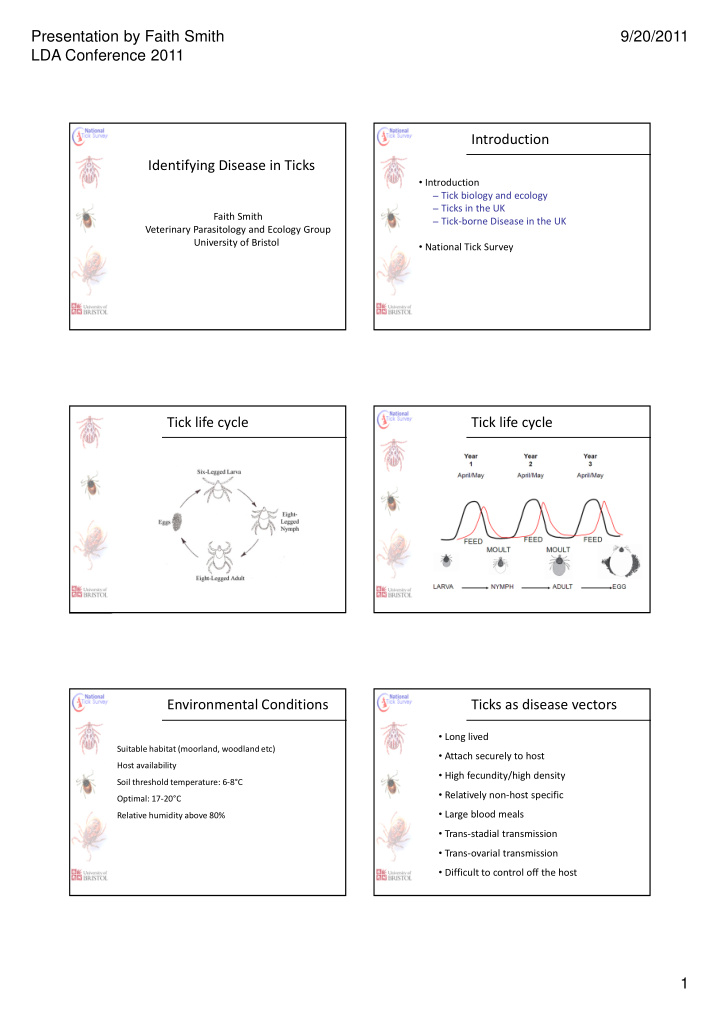



Presentation by Faith Smith 9/20/2011 LDA Conference 2011 Introduction Identifying Disease in Ticks • Introduction − Tick biology and ecology − Ticks in the UK Faith Smith − Tick-borne Disease in the UK Veterinary Parasitology and Ecology Group University of Bristol • National Tick Survey Tick life cycle Tick life cycle • Lifecycle of a tick Environmental Conditions Ticks as disease vectors • Long lived Suitable habitat (moorland, woodland etc) • Attach securely to host Host availability • High fecundity/high density Soil threshold temperature: 6-8°C • Relatively non-host specific Optimal: 17-20°C • Large blood meals Relative humidity above 80% • Trans-stadial transmission • Trans-ovarial transmission • Difficult to control off the host 1
Presentation by Faith Smith 9/20/2011 LDA Conference 2011 Tick species in the UK Tick species in the UK Ixodes hexagonus Ixodes ricinus • Urban parks • Most common species in UK • Inhabits sheltered habitats • Woodland and moorland including burrows • Vector of Lyme borreliosis. • Vector of Borrelia Ixodes canisuga • Boarding kennels and catteries • Not important vector of disease Tick species in the UK UK distribution of ticks • Distribution of Ixodes ricinus expanded by 17%. Dermacentor reticulatus • Perceived abundance increased at 73% of locations. • European Meadow Tick I I • Matches European patterns. • ‘Exotic’ species found in UK • Hosts: livestock, cats and dogs II II Global distribution of ticks Lyme disease prevalence Importance • Lyme disease cases: • 2000 – 0.38 per 100,000 people • Global warming • 2009 – 1.79 per 100,000 people • Introduction of ‘exotic’ species • Four-fold increase! I • 2010 – 953 reported • Introduction of new tick-borne diseases cases, but underreported. II • WHY?? 2
Presentation by Faith Smith 9/20/2011 LDA Conference 2011 Lyme disease Lyme disease Reasons for Lyme increase: Cost of Lyme disease: • Enhanced surveillance • Physician and hospital appointments • More sensitive diagnostic tools • Laboratory tests I I • More diagnostic facilities • Antibiotic therapy • Increase in visitors to Lyme endemic areas • Scotland – loss of £331,000 per year ( Joss et al., 2003 ) • Eastern European migrants II II • Changes in I. ricinus abundance and distribution • Not including loss of working hours and potential • Increases in populations of reservoir hosts decrease in tourism to tick hotspots PhD aims Methods Tick Survey – March-October 2009 • 173 vet practices 1. Distribution and abundance of ticks • 5 dogs/week chosen at random • Dog examined • for disease 2. Distribution and prevalence of disease Methods Results Tick Survey – March-October 2009 • Questionnaire – Risk Factors • Dog movement Dog breed/age/sex • • Preventative treatment • Ticks identified • PCR analysis for disease • 3534 replies • 810 dogs with ticks 3
Presentation by Faith Smith 9/20/2011 LDA Conference 2011 Results Results • 737 dogs with tick samples • 76% had only 1 tick • All samples comprised of only one species Ixodes ricinus I. hexagonus I. canisuga Results Results • Percentage of dogs with ticks per vet practice • Already known established population in west Wales • Evidence of established population in the south east Dermacentor reticulatus Results Results • Percentage of dogs sampled carrying ticks from March-October Risk factors for dogs - Logistic regression: • Not significant: • Significant: • Visits to kennels • Breed type • Visits abroad • Hair length • Acaricide treatment • Neutering • Age • Time of year • Size • Sex 4
Presentation by Faith Smith 9/20/2011 LDA Conference 2011 Identifying disease in ticks DNA extraction • DNA extraction • Ticks stored in alcohol and freezer (-20°C) • Polymerase chain reaction • Tick tissue exposed • Gel electrophoresis • QIAamp DNA kit PCR technique Results • Polymerase Chain Reaction • Primers recognise Borrelia DNA • Cycles of heating and cooling • DNA is exponentially replicated Results Acknowledgements • Professor Richard Wall • Usually Lyme disease prevalence surveys • Dr Eric Morgan • Rachel Ballantyne (Merial) rely on taking blood samples from dogs. • Veterinary Parasitology Group • Advantages of our technique: • Quick and non-invasive • Allowed for a large sample size • Good geographic spread 5
Recommend
More recommend